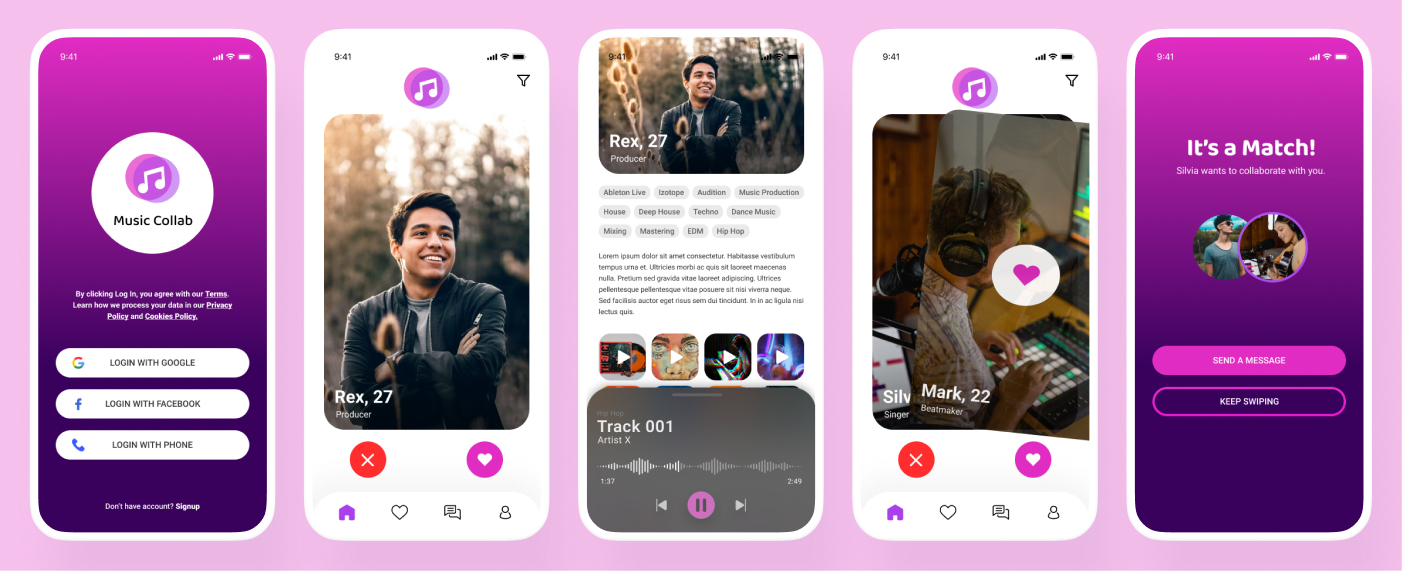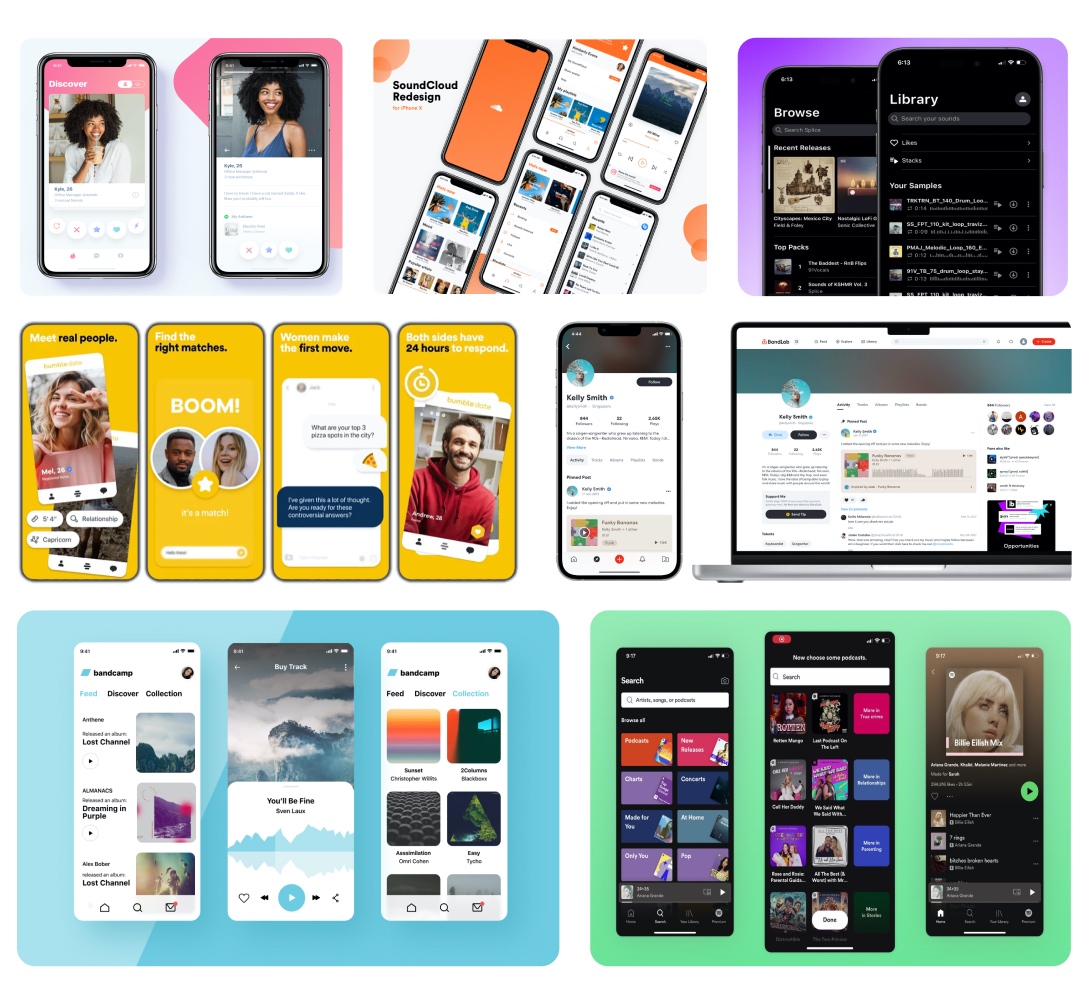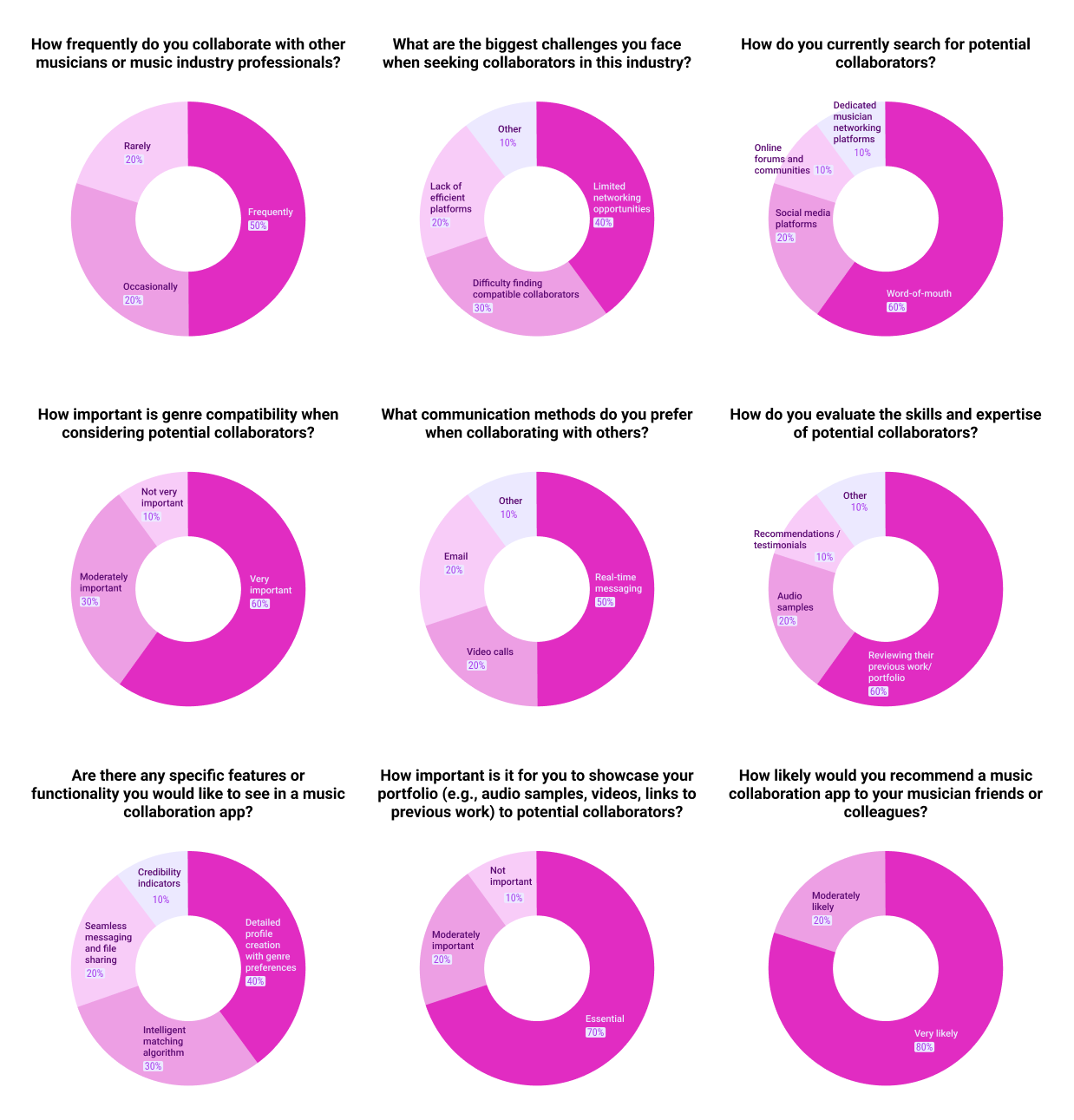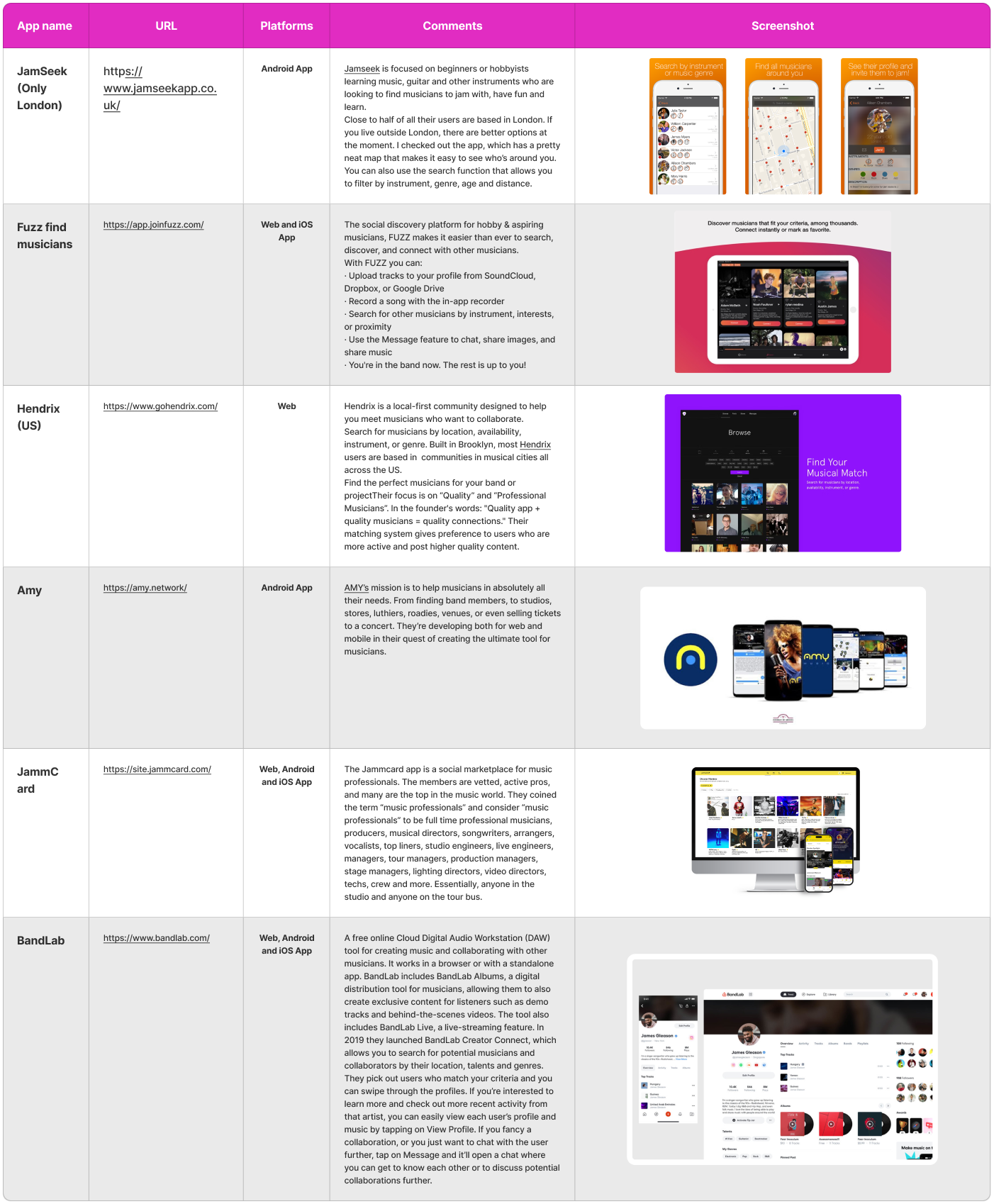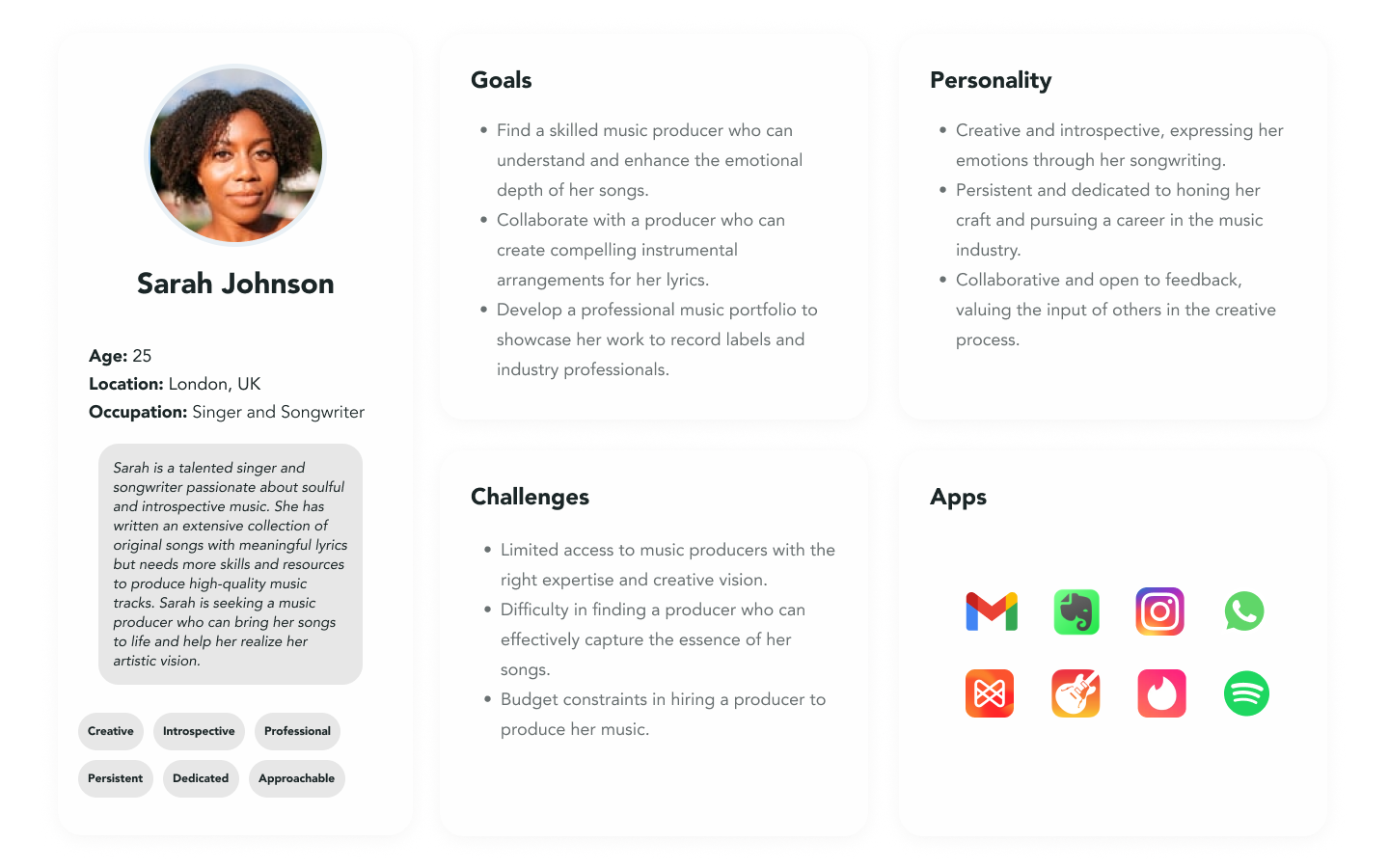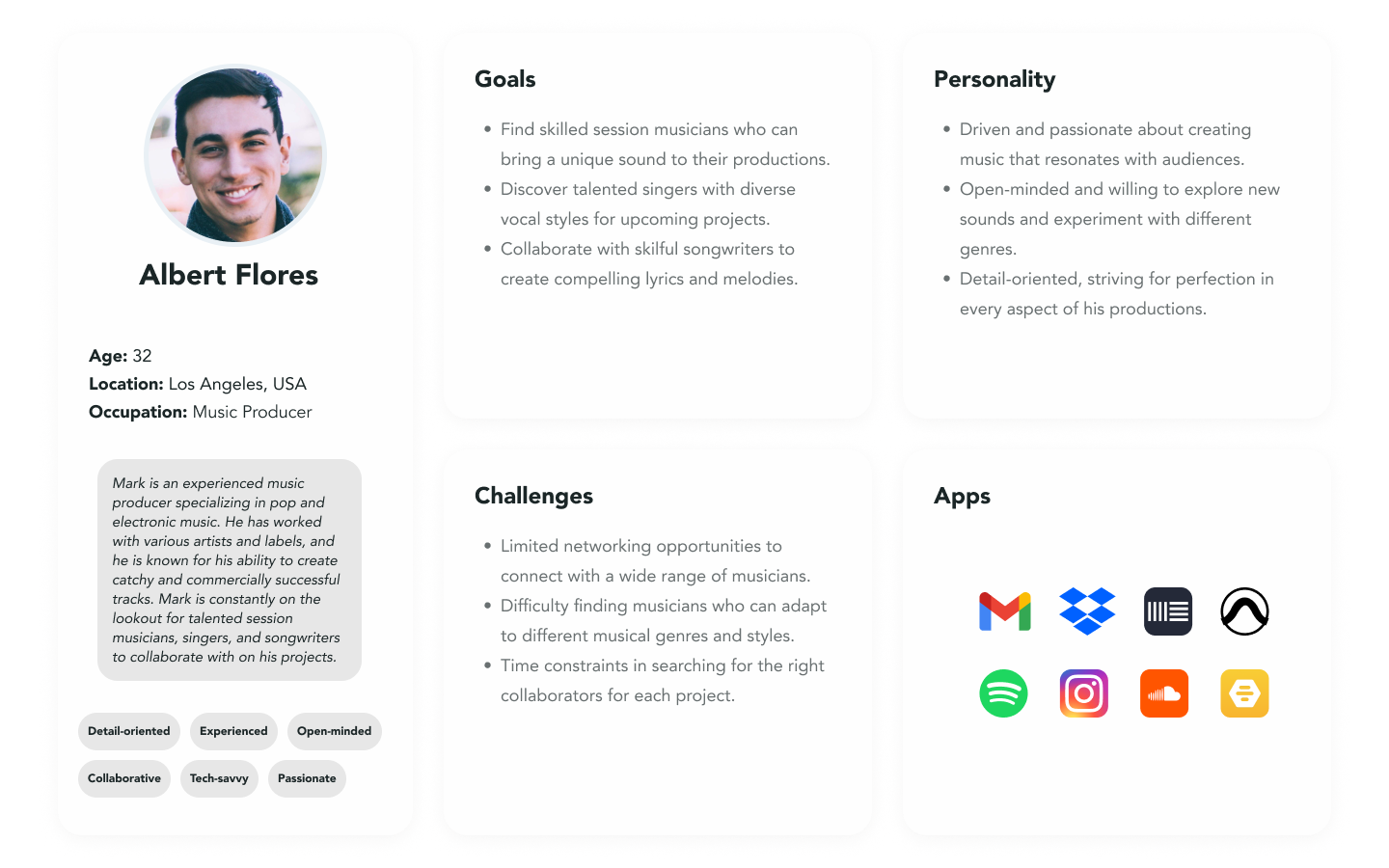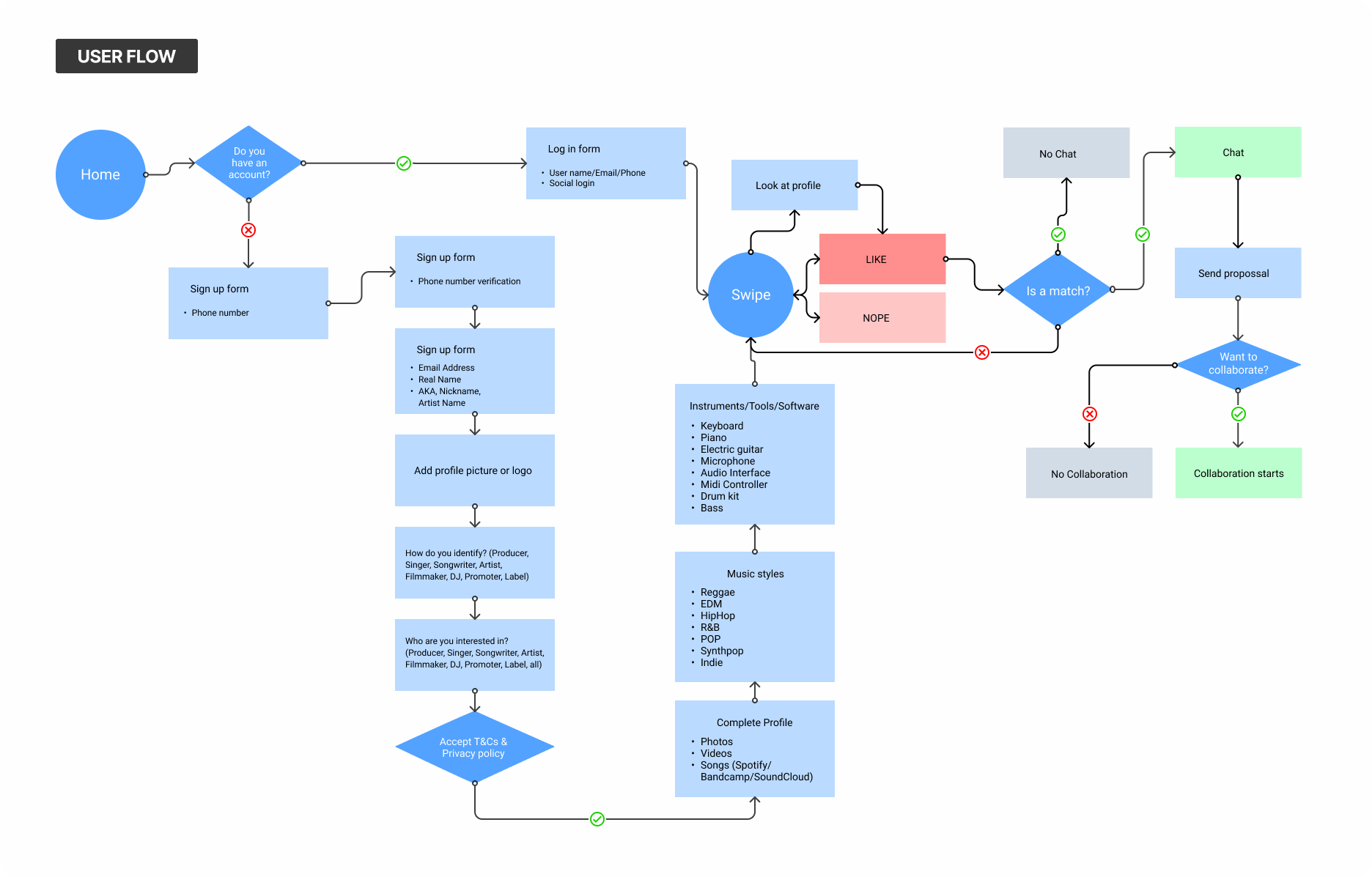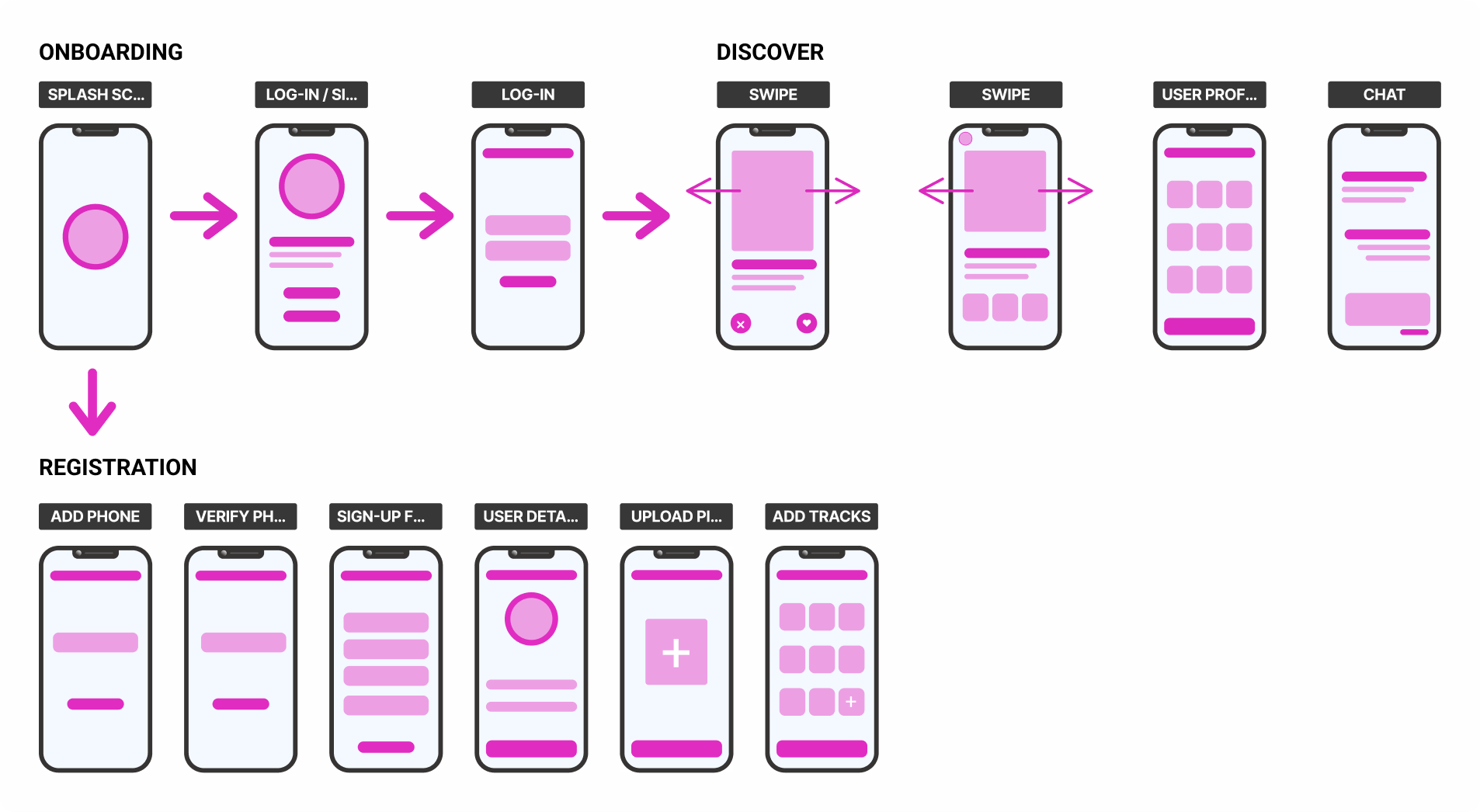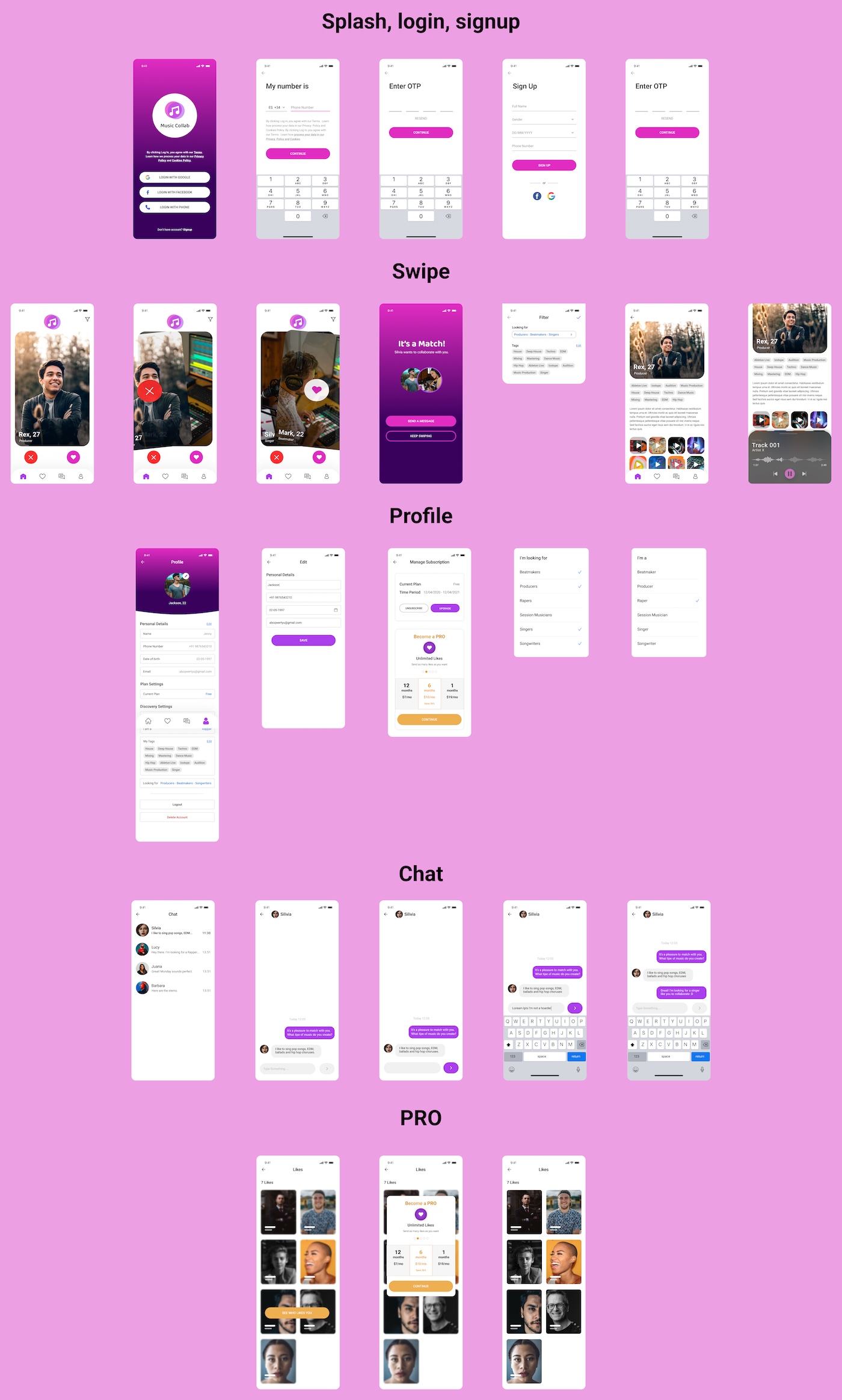Connecting Musicians in a Swipe
Music Collab
Product UX/UI Designer
Figma, Miro
2023
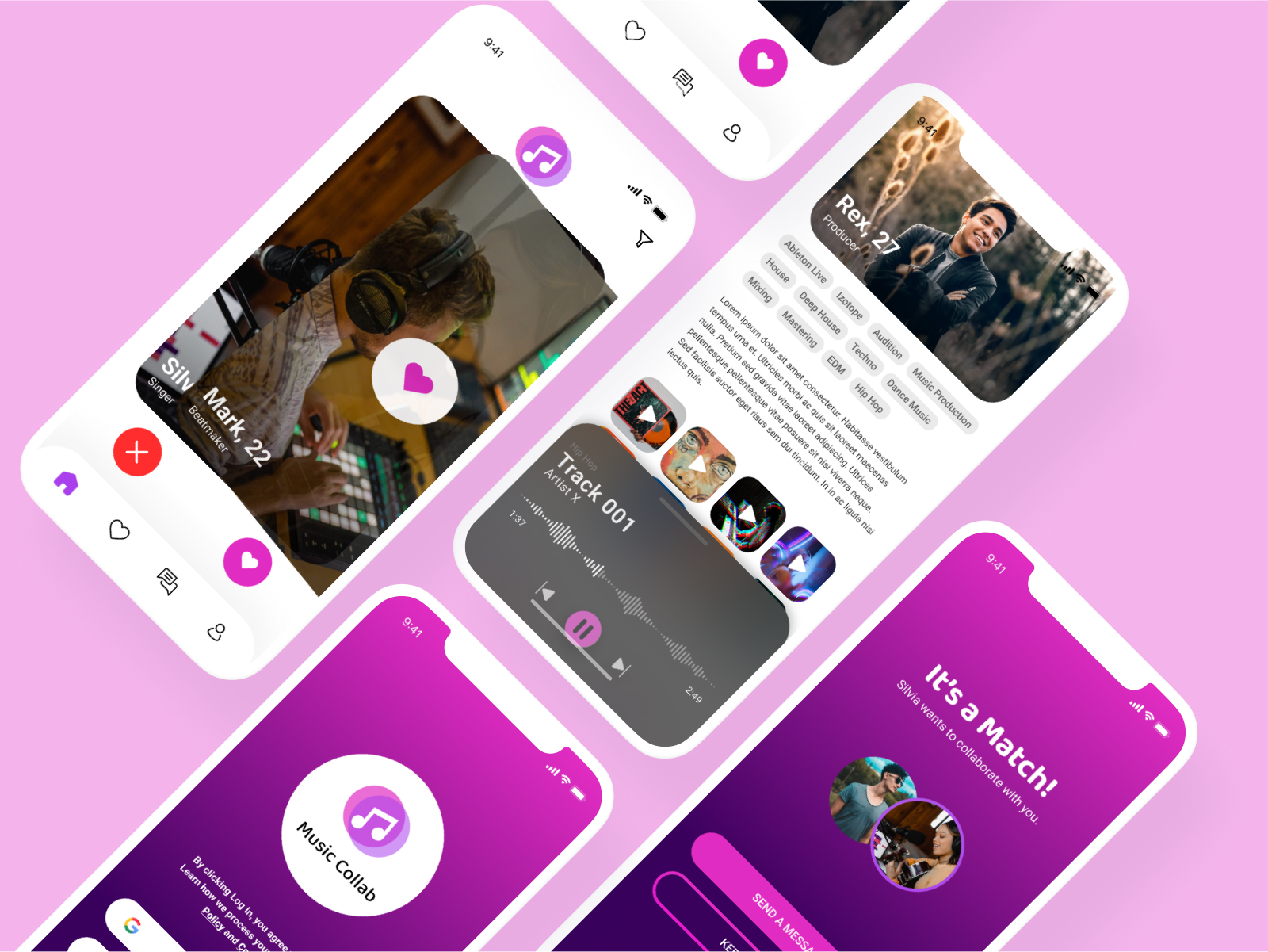
The founders of Music Collab hired me to create a mobile app that would improve the collaboration experience for artists in the music industry. Their vision is to develop a platform similar to Tinder, but specifically designed for musicians, producers, songwriters, rappers and anyone who wants to collaborate in the music world.
In this project, my role as a product designer was to lead the UX/UI design process for the Music Collab mobile app. I conducted user research, created wireframes and prototypes, designed the visual interface, and collaborated closely with the client to ensure that the app met their goals and provided an engaging and efficient experience for musicians seeking collaborative opportunities.
This project has not only allowed me to contribute to the design of a cutting-edge mobile app, it has also provided valuable insights into the unique challenges and opportunities within the music industry.
The Client
Music Collab is an early-stage startup with a mission to revolutionise the way musicians collaborate. With a team of passionate and experienced individuals, the company is dedicated to creating an innovative mobile app that connects musicians more engagingly and efficiently. Their vision is to empower artists to discover ideal collaborators, foster creative partnerships, and transform the music industry through cutting-edge technology. Music Collab strives to unlock boundless possibilities for musical collaboration and bring the joy of creating music to new heights.
The Challenge
As a Product Designer, I faced the challenge of striking the right balance between creativity and usability. In my opinion, it’s essential to design visually appealing interfaces while ensuring that users can navigate the app intuitively. Through careful consideration of user feedback and iterative design processes, I successfully addressed this challenge by creating a seamless and engaging user experience that met aesthetic and functional requirements.
The main challenges included:
- Balancing user needs and app features
- Creating an engaging and unique experience
- Ensuring usability and accessibility
- Managing visual consistency and branding
The SOLUTION
The Music Collab project wants to address the challenges musicians face when searching for like-minded individuals to collaborate with. The process can often be time-consuming and lacks an interactive element to foster creativity and networking. The primary goal was to revolutionise this process by providing a seamless and enjoyable platform for artists to discover and connect with potential collaborators more engagingly and efficiently.
The Process
My design process follows the Design Thinking Methodology, which uses practical methods and tools to promote innovation with a human-centred approach.
To start the process of designing the app, I conducted thorough research by interviewing musicians and music industry professionals, as well as performing a competitive analysis. This research provided me with valuable insights into the needs, preferences and expectations of the users when working with others. Based on my findings, I identified the need for a platform that simplifies the search for compatible collaborators and helps establish meaningful connections.
Using this research as a foundation, I began the design process, which involved brainstorming, creating wireframes, prototyping and visual design stages. Throughout the process, I collaborated closely with the client to ensure that the platform was aligned with their vision and goals. I held regular feedback sessions and made iterations, which helped me to refine the platform’s look and feel, features, and functionality.
As a result, we created a prototype that meets the needs of the target users and delivers value to the music industry.
The Research
During the research process, I delved into a thorough competitive analysis, explored various existing apps for design, usability, and feature inspirations, and conducted interviews with 10 professionals in the music industry, which included 2 music producers, 3 beatmakers, 2 session musicians, and 3 singers/songwriters.
By immersing myself in the landscape of music collaboration platforms, I gained valuable insights into industry trends, user preferences, and areas for innovation. These findings, combined with the responses gathered from the interviews, were pivotal in shaping the design and features of the Music Collab app to ensure it resonates effectively with its target audience and addresses their pain points and needs. For instance, we introduced genre-based matching, versatile communication tools, and portfolio showcasing options. All of these features would enhance the collaboration experience for the users, leading to a more successful outcome.
Key Interview Insights
- Collaborative Challenges: Musicians expressed frustration in finding compatible collaborators due to limited networking opportunities and a lack of efficient platforms. Many highlighted the time-consuming nature of traditional methods for discovering and connecting with potential collaborators.
- Search and Discovery Process: Traditional networking methods like events and personal connections still play a role in the search and discovery process, but online platforms and social media are also powerful tools for finding collaborators. Musicians use dedicated music networking websites and social media groups to connect with like-minded artists.
- Genre Compatibility: The interviews revealed that genre compatibility was a significant factor in collaboration. Musicians emphasized the importance of finding collaborators who shared similar musical styles and had a deep understanding of specific genres. This highlighted the need for a platform that could facilitate genre-based matchmaking.
Competitive Analysis
The competitive analysis played a crucial role in understanding the landscape in which the Music Collab app would operate. By examining and evaluating the strengths and weaknesses of existing competitors in the music collaboration space, we gained valuable insights into market trends, user expectations, and potential opportunities for differentiation. This analysis served as a foundation for making informed design decisions and crafting a unique value proposition that set the Music Collab app apart from its competitors.
The User Personas
These user personas provide insights into the backgrounds, goals, challenges, and personalities of potential users of the Music Collab app. Understanding the needs and motivations of these personas will help inform the design and features of the app to cater to their specific requirements.
The User Flow
This flowchart details the step-by-step journey of a music producer using the Music Collab app to discover session musicians, singers, or songwriters and connect with them. We have used this tool to visually map out the journey of the users, from their perspective and around their goals, which has helped us understand and optimise the interface and the experience.
The Wireframes
In the process of designing the Music App, I’ve created simple wireframe sketches. These sketches help outline how the app will look and function, mapping out its layout and user journey.
The main aim of these early wireframes is to quickly explore different design ideas without getting too caught up in specifics. By doing this, we can gather feedback from stakeholders and make sure we’re on the right track before investing a lot of time and effort into the final design.
The Prototype
To validate and improve the user interface design and the overall experience, I developed a high-fidelity prototype for user testing using Figma and then carried out usability testing sessions with musicians and music industry professionals. Their insightful feedback was instrumental in refining the user flow, enhancing feature discoverability, and improving overall usability.
The Final Design
I am proud of the UX/UI design we created for Music Collab. We aimed to give the app a modern and sleek look, so I used vibrant colours inspired by the dynamic nature of the music industry to create an engaging and energetic atmosphere. To ensure a cohesive and visually pleasing experience for users, I established a consistent visual language throughout the app. I also incorporated the client’s branding elements and colour scheme into the design, reflecting the diverse nature of music genres. We also crafted the app’s features to facilitate an efficient and enjoyable collaboration process, enabling users to find the perfect collaborators for their music projects.
Key Features:
- Extended user profiles to highlight musicians’ preferred genres, skills, and experience.
- Portfolio showcasing options enabling musicians to present their work effectively.
- Intelligent matching algorithm.
- Swipe-to-connect mechanism.
- Seamless messaging interface.
- Media-sharing functionality.
THE RESULTS
Through embracing challenges and utilizing user-centric design principles, I was able to overcome obstacles and iterate on designs, resulting in the development of an engaging, user-friendly, and aesthetically pleasing Music Collab app that caters to the unique needs of musicians in the collaborative music industry.
- Enhanced User Experience: By prioritizing a user-centric approach, I have created an app that delivers an exceptional user experience. This emphasis on user experience enhances user satisfaction and engagement, ultimately leading to a successful app launch.
- Targeted Feature Development: The research conducted with music industry workers has provided valuable insights into their collaboration needs and pain points. By incorporating these findings into the UX/UI design process, we have been able to identify and prioritize key features that address the specific challenges faced by the users, enhancing the app’s overall value proposition.
- Reduced Development Costs and Time: The research-driven UX/UI design approach has played a vital role in reducing development costs and time. By conducting user research upfront, we gained a deep understanding of user expectations and preferences, enabling us to make informed design decisions. This reduced the need for significant design changes during the development phase, resulting in a streamlined development process and optimized resource allocation.
Key Takeaways
As we come to the end of our journey with the Music Collab app, it’s time to reflect on the valuable insights and lessons learned during the design process. In this section, we will discuss the key takeaways derived from our experience, which offer valuable insights not only for future iterations of the app but also for broader discussions surrounding digital innovation and user-centric design in the music industry.
- User-Centric Design: Ensuring that an app meets the needs and preferences of its intended users is key to its success. By conducting user research and involving them at every stage of the design process, the project adopted a user-centred approach, which helped us gain a better understanding of their pain points, aspirations, and collaboration requirements. This resulted in higher user satisfaction and engagement.
- Balancing Simplicity and Functionality: Striking the right balance between simplicity and functionality is crucial in designing a user-friendly app. The challenge lies in offering a rich set of features while keeping the interface intuitive and easy to navigate. Through careful prioritization and iterative design, I learned how to simplify complex functionalities without compromising on the app’s overall usefulness.
- Iterative Design Process: The project demonstrated the value of an iterative design process. By continuously gathering feedback, testing prototypes, and refining the design based on user insights, the app evolved and improved over time. This iterative approach ensured that the final design was both functional and user-friendly, meeting the expectations of musicians and aligning with their workflow.
- Importance of Visual Appeal: The music industry is inherently creative, and aesthetics play a significant role in capturing musicians’ attention. The project highlighted the importance of creating visually appealing interfaces that reflect the dynamic and vibrant nature of the music industry. A visually engaging design can attract and engage users, making the app more memorable and enjoyable to use.
- Embracing Collaborative Ideation: The Music Collab project underscored the power of collaborative ideation in driving innovation. By fostering an environment where ideas were openly exchanged among team members, stakeholders, and even potential users, we witnessed firsthand how diverse perspectives and insights can fuel creative solutions. This collaborative approach not only enriched the design process but also led to the development of features and functionalities that resonated more deeply with the needs and aspirations of musicians. Moving forward, embracing this culture of collaboration will continue to be instrumental in nurturing innovation and ensuring the continued success of Music Collab’s endeavours.
Next Steps
As we are wrapping up our Music Collab project exploration, it’s important to think ahead and consider what’s next on our journey. We’ve come a long way in designing the app, but there is still room for improvement and expansion. In this section, we’ll highlight the areas we need to focus on and the action points that will guide us moving forward. From making the user experience better to exploring new features and functionalities, these next steps will help us keep innovating and take the Music Collab app to new heights.
- Usability Testing: Conduct comprehensive usability testing with a diverse group of musicians to gather feedback on the app’s functionality and user experience. Analyze the findings and identify areas for improvement or refinement. Iterate on the design based on the feedback received to enhance the app’s usability and address any pain points or usability issues.
- Continuous User Research: Maintain an ongoing user research effort to stay updated with the evolving needs and expectations of musicians. Regularly engage with the user community through surveys, interviews, and feedback channels to gather insights and identify opportunities for further improvement. This continuous user research will help ensure that the app remains relevant and aligned with the ever-changing dynamics of the music industry.
- Analyze User Data and Iterate: Gather and analyze user data to gain insights into user behaviour, preferences, and usage patterns within the app. Utilize analytics tools and user tracking to identify areas where users might encounter obstacles or drop-off points. Use this data-driven approach to identify opportunities for optimization and further enhance the app’s user experience. Iterate on the design based on these insights to improve user engagement, retention, and satisfaction.
